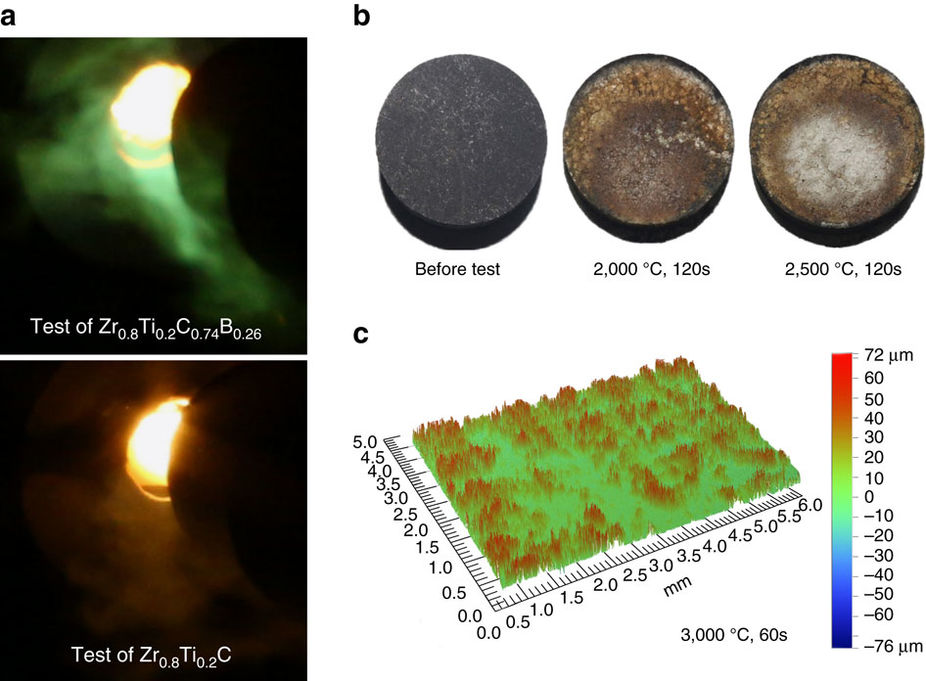New ablative protection of missiles and airplanes does not evaporate even at 3000 ° C

Future supersonic airplanes can significantly reduce the time of transcontinental flights: it will be possible to fly from Moscow to New York in three hours, but one of the main problems in their development is the protection of critical components, such as the wing toe (front edge), the nose fairing (nose ) and combustion chambers of jet engines. At a speed of 5 or more Machs they undergo powerful oxidation and extreme temperatures that reach 2000-3000 ° C (Mach number corresponds to the speed of sound: for example, at an altitude of 11 km it is 295 m / s or 1062 km / h).
In recent years, there has been active work on the creation of ceramic coatings, but the best of them managed to withstand only a relatively low temperature of 1200–1500 ° C, after which some elements evaporated as a result of ablation , that is, the structure of the coating was disturbed. Now a group of scientists from the Royce Institute at the University of Manchester (UK) and the Central Southern University (China) has developed a new material with improved characteristics that can withstand temperatures up to 3000 ° C without structural changes. This ceramic coating is Zr 0.8 Ti 0.2 C 0.74 B 0.26 , which is superimposed on the C / C carbon-carbon composite matrix using reactive melt infiltration and cementation.
In its characteristics, the new coating significantly exceeds the best high-temperature ceramics (ultra-high temperature ceramics, UHTC), not to mention the samples of the past. For example, the lower and side surfaces of the Buran airframe were covered with TZMK-10 and TZMK-25 ceramic tiles with a working temperature of up to 1,250 ° C. American counterparts Li-900 and Li-2200 had about the same characteristics. Ceramic coating of Zr 0.8 Ti 0.2 C 0.74 B 0.26 on the carbon-carbon composite can withstand 3000 ° C. It is an order of magnitude better than zirconium carbide (ZrC), which today is traditionally used to coat cutting tools.
For example, the graph below shows the ablation resistance (MAR and LAR) of various heat-resistant materials that are used today in industry, aviation and astronautics. The tests were carried out in the machine for acetylene-oxygen cutting. As you can see, Zr 0.8 Ti 0.2 C 0.74 B 0.26 (round marks in the green field) radically surpasses all other materials in tests of different duration and at different temperatures. The indicator MAR denotes the mass ablation rate (mass ablation rate), that is, the evaporation rate of a coating substance. Indicator LAR (linear ablation rate) means the rate of linear ablation and corresponds to the spatial stability of the material. For example, ZrC at a temperature of 2500 ° C loses 1.10 mg of mass per square centimeter per second, and Zr 0.8 Ti 0.2 C 0.74 B 0.26 - only 0.14 mg.

In other tests at 2000–2500 ° C, the material shows near-zero weight loss or weight gain (due to oxidation), which means excellent heat resistance and negligible ablation in a stream of hot gas.
The photographs show the dark gray surface of the material before testing, as well as the surface after two minutes of testing at a temperature of 2000 ° C and 2500 ° C. In the center of the right sample is the area where the flame temperature reached 3000 ° C. There are visible traces of ablation and convexity with a height of less than 72 microns due to evaporation of oxides with a low melting point, but there are no cavities on the surface and holes in it due to ablation.

The material was developed in the UK and manufactured at the Institute of Powder Metallurgy of the Central Southern University of China. The researchers emphasize that the use of process technology with reactive melt infiltration drastically reduces the time required for manufacturing. The second important innovation is the deposition on a matrix of carbon-carbon composite, which significantly increased the heat resistance of ceramics.
The chemical structure of heat-resistant ceramics itself plays the role of a protective mechanism. At a temperature of 2000 ° C, Zr 0.8 Ti 0.2 C 0.74 B 0.26 materials and SiC oxidize and turn into Zr 0.80 T 0.20 O 2 , B 2 O 3 and SiO 2 , respectively. Zr 0.80 Ti 0.20 O 2 partially melts and forms a relatively dense layer, while oxides with a low melting point of SiO 2 and B 2 O 3 evaporate through the “evacuation channels” holes (illustration a below). At a higher temperature of 2500 ° C, Zr 0.80 Ti 0.20 O 2 crystals fuse into larger formations, closing the holes (Figure b below). At a temperature of 3000 ° C, an almost absolutely dense outer layer is formed, mainly consisting of Zr 0.80 Ti 0.20 O 2 , zirconium titanate and SiO 2 (Figures c , e below).

The new ablative protection can be used not only in supersonic military and civil aircraft, but also in spacecraft, returnable space modules, rockets, missiles, aircraft engines, etc. Of course, it can be used to cover working surfaces in drills, cutters and other tools that are exposed to high temperature - for strength and durability of the product.
The scientific article “Ablation-resistant carbide Zr 0.8 Ti 0.2 C 0.74 B 0.26 for oxidizing environments up to 3,000 ° C” was published on June 14, 2017 in the journal Nature Communications (doi: 10.1038 / ncomms15836).
All Articles